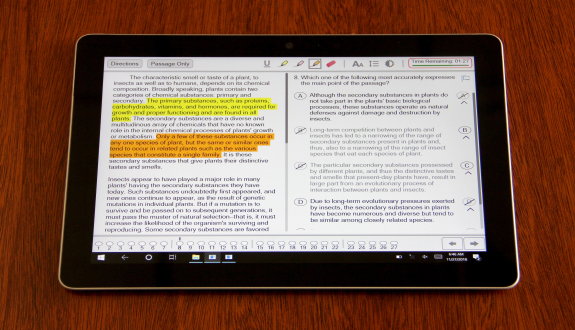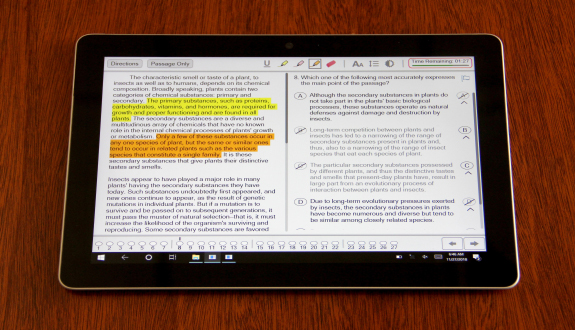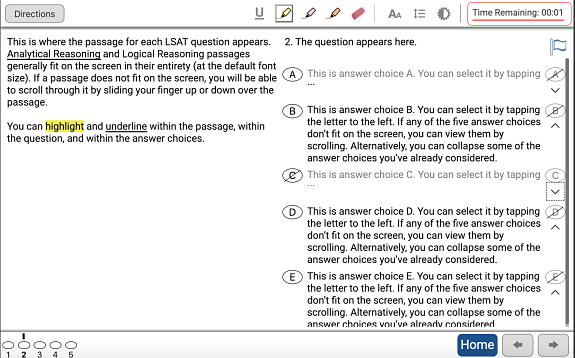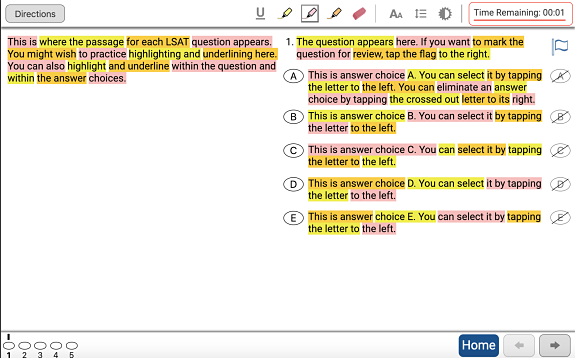You Can Now Test Out the Digital LSAT
- by
- Jan 10, 2019
- LSAT
- Reviewed by: Matt Riley


When LSAC announced that the LSAT would switch to a digital format in July of 2019, we knew big changes were coming to this test. But some of us may have underestimated how significant these changes would feel. Well, OK, I’ll be honest and use “I” statements and say that I may have underestimated how significant these changes would feel.
For instance, I — lacking both intelligence and forethought — assumed that test takers would be perfectly content to do one of the most important tests of their lives on a completely unfamiliar format. That they — in addition to completing the difficult material in a stressful environment — would happily figure out how the new testing software works, on the fly and within the severe time constraints imposed by the test.
But, after doing a couple presentations on the digital LSAT, it became clear that many prospective test takers — having both the intelligence and forethought that I lacked — were not quite as content to put their fates in the hands of an unknown digital format. “Are they going to let us see or play around with the new digital software beforehand?” these bright and inquisitive minds would ask. “Uhh, that’s a good question,” I would mutter (my go-to response when the more truthful response would be, “I don’t know the answer to that question.”). My stammered follow-ups, which could be summarized as, “IDK probably ¯_(ツ)_/¯,” didn’t instill much confidence in these future attorneys.
Fortunately, when LSAC — also apparently in possession of at least some intelligence and forethought — elaborated on the digital LSAT last month, they let everyone know that they would offer some services that would allow prospective test takers to get acquainted with the digital software LSAC would start using in July 2019. And now that registration for the July 2019 LSAT officially opened today, LSAC unveiled these services.
So, if you’re thinking about taking the LSAT in July 2019 (at which half of the test takers will be assigned the new digital test) or the LSAT in September 2019 or beyond (at which all of the test takers will be assigned the new digital test), you should take a look at these tools. For each section of the LSAT there’s a tutorial, in which a robotically voiced woman slowly and methodically shows you everything you can do with the new digital format. These videos are a bit of a tough hang, and they’re not going to win any craft awards during this Oscars season, but they’re nonetheless a useful resource worth checking out. Even though we’ve had a pretty good idea of what the digital exam would look like for some time, there were a few tools that I wasn’t previously aware of. Like, if all of the answer choices don’t fit on the screen, there’s a little arrow you can click on that will collapse the answer choice.

In addition to the tutorials, there’s the option to play around with the digital software. If you’re more of a hands-on learner, you can use this feature to figure how to highlight and underline the text, how to jump around to the various questions, how to flag questions, how to cross off answer choices, and so on. You might also make some new discoveries. If you find the online interface quite drab and uninspired — as I do — you’ll learn that you can use the various highlighters to make the text pop with color and beauty:

But one thing I realized while playing around with this format was that I habitually mark up these quesitons in a bunch of a different ways, and the digital interface wouldn’t let me do any of these. Like, in addition to underlining or highlighting conclusions, I like to circle new terms in the conclusion. Or, sometimes, I like to quickly jot down a summary of the premises. Or write which fallacy is being committed, or the principle that would strengthen an argument, or the causal relationship asserted by an argument. Or, you know, diagram the many conditional statements that show up on this exam. Highlighting, underlining, changing the text size, collapsing answer choices, flagging questions — those are all nice features, but none of those would let me write out the things that help me answer these questions. Those who take the digital LSAT will be given scratch paper to work with — a luxury not afforded to those who take the traditional paper-and-pencil LSAT — but for me, at least, that’s not the same as marking up the actual question.
Maybe LSAC will make updates to this digital interface that will eventually allow test takers to write on the questions. But until that hypothetical day comes, the online interface you see on these tools is the online interface you’ll see in July and beyond. If you are an old dog reluctant to learn new tricks — as I definitively am — you might want consider signing up for the March or June LSATs (the registration for which also opened today), since those are the last surefire paper-and-pencil exams. But if you decide you’re happy taking the new digital LSAT, the tutorials posted on LSAC’s website are certainly a valuable resource.
Search the Blog

Free LSAT Practice Account
Sign up for a free Blueprint LSAT account and get access to a free trial of the Self-Paced Course and a free practice LSAT with a detailed score report, mind-blowing analytics, and explanatory videos.
Learn More
Popular Posts
-
logic games Game Over: LSAC Says Farewell to Logic Games
-
General LSAT Advice How to Get a 180 on the LSAT
-
Entertainment Revisiting Elle's LSAT Journey from Legally Blonde








